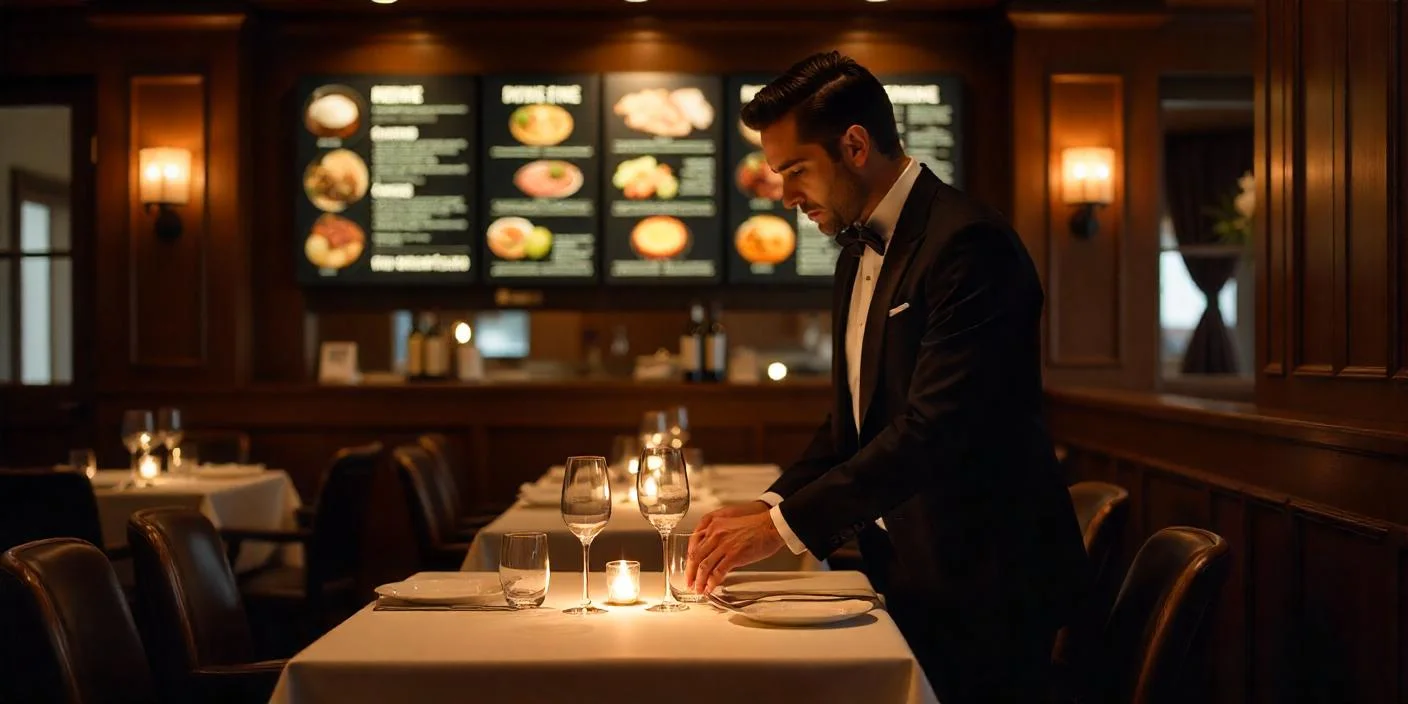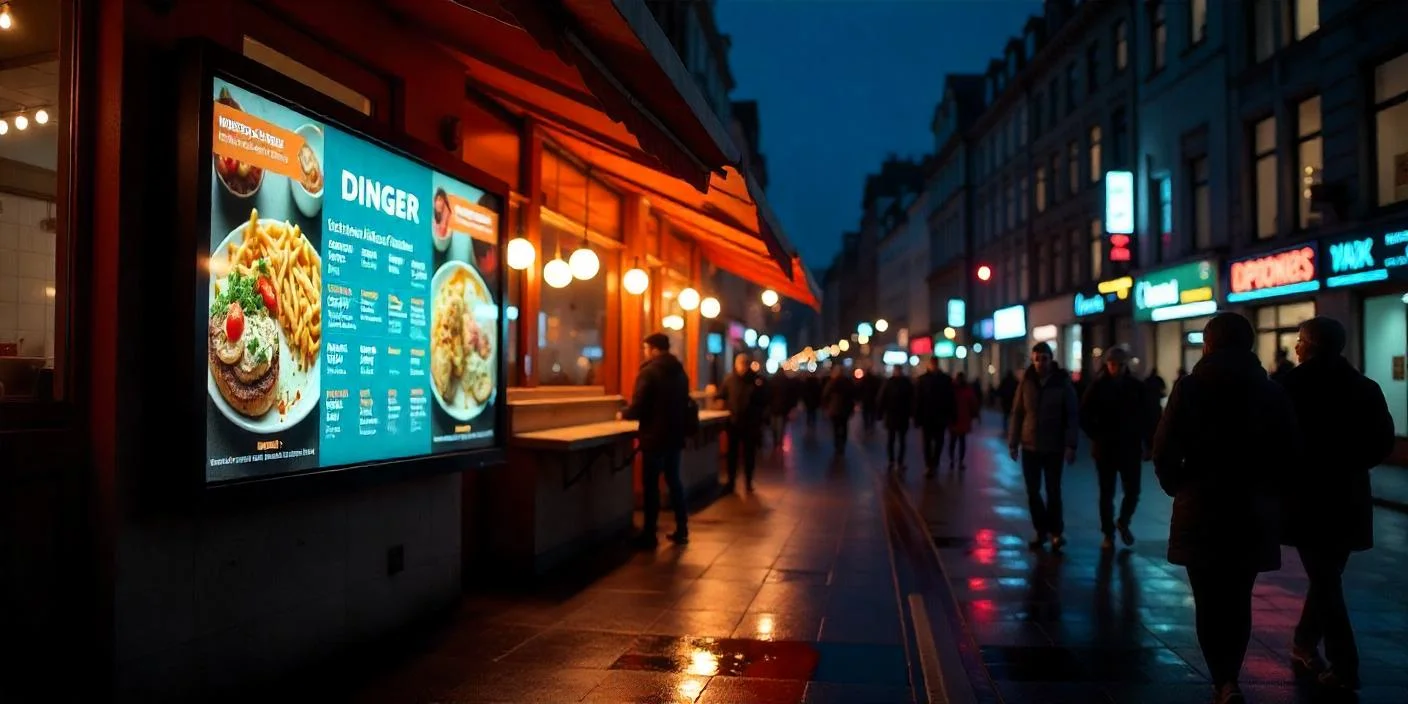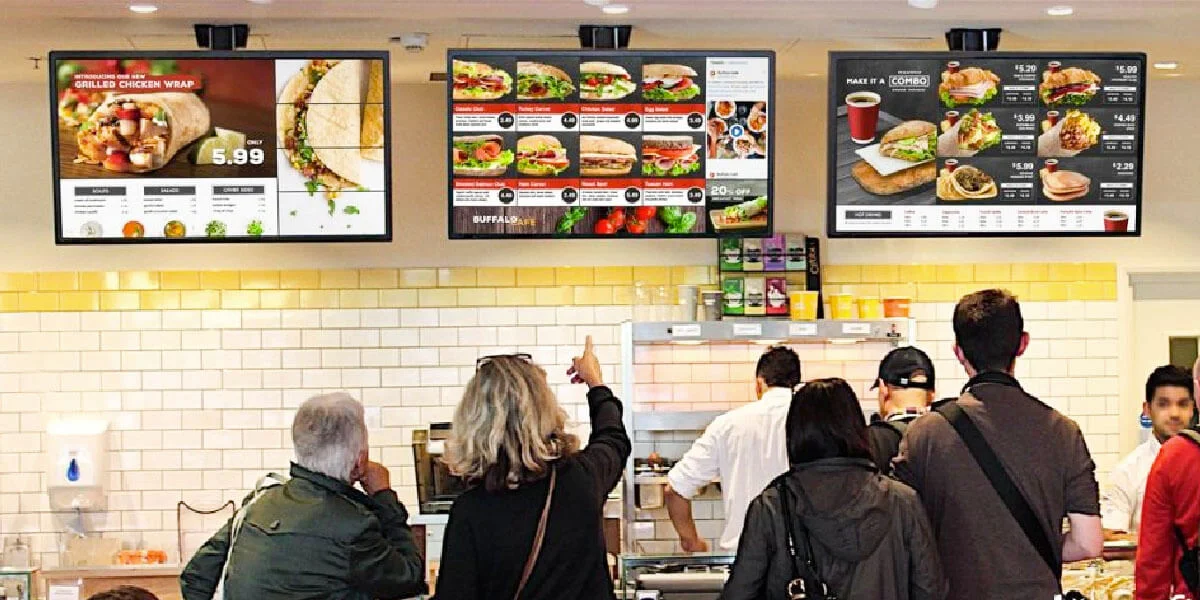With smart restaurant screens, food service environments are being transformed since these screens merge interactive hardware, cloud-based software, and real-time information for a better experience. Equipping restaurants with a strong, smart restaurant solution powered by digital signage can turn regular screens into engaging spaces that provide information and enjoyment and help the business earn more. LED video walls in mall food courts and tableside tablets in fine restaurants help eateries show targeted content, make their work more efficient, and attract loyal customers.
1. Introduction to Smart Restaurant Screens

Because today’s diners look for convenience and personalization, traditional chalkboards and paper menus are no longer popular. Whether they are high-resolution LED screens for restaurants, interactive menus, or video walls, smart restaurant screens help connect guests with the kitchen staff. They show menus that update in real-time, recommend extra items according to what people usually order, and alter the content depending on the room. When establishments use a complete smart restaurant system, the entire dining process is enhanced from the moment guests arrive until they settle the bill.
2. Evolution of Restaurant Technology
There has been a fast transition in the hospitality industry from using simple POS devices to using touchscreen ordering kiosks and mobile loyalty apps. Today’s progress is made possible by AI, IoT sensors, and cloud-native digital signage video wall software. Together with other smart features, like ordering with your voice and being recognized by your face for loyalty, the screens turn into complete control centers for the restaurant. They easily work together with kitchen display systems, let workers check table status from elsewhere, and present personalized offers to diners while they look at the menu. With progress in technology, these screens will be more important in our daily routines.
3. What Is a Smart Restaurant System?
A smart restaurant system is made by joining together different pieces of hardware and software.
Hardware
Restaurants make use of LED screens that are very bright, along with interactive kiosks and tablet terminals.
Software
Cloud-based tools that support menu screens, scheduling, and analytics on digital displays.
Automation
Up-sell engines that use AI, motion sensors, and integration with POS, CRM, and delivery systems.
With this, restaurants get real-time menu changes, specific recommendations, and data-supported decisions, making the digital backbone of today’s eateries.
4. Defining the Smart Screen Policy in Hospitality

Implementing technology in restaurants calls for having clear policies.
Privacy & Security
All communications with customers on restaurant screens should be encrypted and follow the PCI-DSS standard.
Content Guidelines
It is important that menus, ads, and images follow the brand standards and are updated on a schedule without any human help.
Energy Management
Screens should automatically dim when nobody is around and go to sleep mode at night to use less power.
An effective smart screen policy helps technology benefit the guests while still maintaining the proper guidelines for the hotel.
5. Smart Restaurant Features That Are Changing the Game
Smart restaurant features are used by modern eateries to make their customers happy and keep them coming back. Speaking to order is helpful for anyone who needs assistance, and AI suggests drinks that go well with what the customer has bought before. When a guest returns to the same location, their face will be recognized, and they’ll receive a discount immediately. With these features combined, both personalization and convenience are better than ever.
6. The Role of Digital Menu Screens in Modern Dining
Restaurants can now present their menus in an exciting way thanks to digital screens. Rather than printing new menus for each type of special or allergy, the CMS allows chefs and managers to make changes immediately. The screens update their menus during the day, starting with breakfast in the morning, then lunch, and finally dinner, without any need for physical menus. Joining flexible content with cool visuals allows places to stay up-to-date and handle their business smoothly.
7. LED Display Screen for Restaurant Branding & Promotions
A high-definition LED screen used for restaurant branding is not only stylish but also brings strong value to the business. On the outside, LED video walls invite people in with active specials, and on the inside, animated motion graphics help sell the chef’s favourite dishes. If restaurants personalize their menus for the seasons, weather, or nearby festivals, they can strengthen their identity and make people spend more. Being part of a video wall network gives these displays great potential for telling stories.
8. Enhancing Customer Experience with Interactive Restaurant Screens

Restaurant screens allow guests to choose their meals according to their diet, discover the origins of each ingredient, or enjoy a short cooking video. Because multiple diners can use the multi-touch panels, they can view menus faster, and the turnover at tables increases. Playful gesture controls and proximity sensors help restaurants offer a better experience for their customers.
9. Smart Menu Explained: What Is a Smart Menu?
A “smart menu” makes it possible for customers to select from various options. AI allows the menu to automatically hide products that are not available, highlight the best-selling items, and offer suitable add-ons to every guest. You can place your order without touching a screen by saying it aloud or by using their mobile app. Basically, a smart menu is a flexible digital tool that uses information to improve how diners decide what to eat.
10. The Seamless Integration of Smart Restaurant Solutions
Things become more efficient when digital menu screens, kitchen displays, POS terminals, and analytics dashboards are able to communicate with each other. When a video wall order is placed, it is sent right away to the chefs; changes in the inventory show up in menu options; managers check real-time stats on their tablets. Every part of the process is connected, so everything runs smoothly, and guests are happy.
11. Restaurant Menu Display Strategies That Work
Bold headings for main dishes, eye-catching images for the chef’s specials, and clear coloring for limited-time items are the best ways to display menu items. Animations make it easy for the viewer to follow from one part of the screen to another, and the use of strong colors makes the information readable no matter the distance. Displaying “Would you like a drink for $2?” after someone chooses their main dish can bring in a lot of extra income for restaurants using digital signage.
12. How Digital Signage for Restaurants Improves Operational Efficiency
Digital signage in restaurants helps improve how things are handled behind the scenes. Manual menu changes are no longer needed, so the time and money spent on them are saved, and prices and promotions are updated as planned by the system. Staff are now able to provide better service since screens manage the display of customer information for them.
13. Smart Restaurant Screens and Real-Time Updates
Because they can send out real-time updates on events, restaurants have greater control than ever. If the ingredients available in the kitchen differ, the screens are updated to hide any unavailable meals. Promotions done when foot traffic is low can encourage sales when times are slow. Because of smart restaurant systems, both diners and staff can respond quickly to changes.
14. Data-Driven Insights Through Smart Restaurant Systems
Whenever a customer uses the restaurant screen, it records information. The use of dwell time, touch interactions, and QR codes gives insights into analytics dashboards, showing the most wanted meals and lesser-used promotions. Restaurants can use this data to review their menus, adjust how many employees are scheduled, and improve their marketing, all based on what diners actually do.
15. Sustainability and Energy Efficiency of Smart Screens
These modern screens are developed with the environment in mind. If your device adjusts its brightness depending on the light around it, you will use less power. Several hardware providers supply recyclable pieces and parts with extended lifespans, which allows restaurants to be more environmentally friendly and lower their daily costs.
16. Security Considerations and Smart Screen Policy Enforcement
It is important to put strict security measures in place when rolling out many smart restaurant screens. Any data shared between the hotel and guests, including loyalty and payment details, has to be encrypted and meet PCI-DSS standards. It is important to set a clear smart screen policy that tells who has permission to upload content, manage playlists, or adjust schedules. Frequent audits, updates of the security software, and training of employees help keep your screens safe and working properly.
17. Challenges Restaurants Face When Implementing Smart Screens

Even with the benefits, it can be hard to implement. The high price of LED displays, challenges in connecting with old POS systems, and workers not wanting to change their routines are some of the biggest problems. Keeping content updated frequently and creative can be very demanding for resources. To deal with these challenges, one must introduce the system in stages, train employees properly, and partner with vendors who assist throughout the process.
18. Future Trends in Smart Restaurant Screen Technology
Soon, you will see holographic menus above counters, augmented-reality displays showing food close-ups, and AI agents talking to customers using voice interfaces on restaurant screens. Using blockchain for loyalty and biometric payments will make things easier, while predictive analytics will help to accurately predict what is needed in the kitchen every hour, ensuring personalized dining experiences.
19. FAQs on Smart Restaurant Screens
Q1. Are smart restaurant screens suitable for small restaurants?
Absolutely. Kits that use tablets and LED screens allow smaller restaurants to enjoy the main features of digital menus without having to invest a lot.
Q2. Can digital menu screens work offline?
Most of the restaurant’s digital signage platforms allow for offline access to their content. Even if the connection is lost, scheduled videos will still play; when the network is back, they will be updated on the cloud.
Q3. How often should content be updated on a restaurant screen?
Brand content that is seasonal or promoted should be updated every week or each day, whereas evergreen brand images can be updated just once a month. If something runs out on the menu, that change should be updated immediately through your smart restaurant system.
Q4. What’s the lifespan of an LED display screen for restaurants?
It is normal for a good LED screen to remain in use for 5 to 10 years, depending on how often it is used and how well it is taken care of. It is possible to replace just the panel with a modular design rather than the whole system.
Q5. Do smart screens require staff training?
Yes. Even though modern interfaces are user-friendly, you should still train staff on how to deal with content updates, solve minor issues, and follow the smart screen policy.
Q6. Can screens be customized for different languages or regions?
Certainly, because international chains and diverse communities need it, advanced restaurant digital signage systems offer multilingual support and content that matches different regions.
Q7. Are there smart restaurant solutions that integrate with delivery apps?
Yes. Menus in leading smart restaurant systems can be automatically synced with Uber Eats and DoorDash, which reduces the need for manual work.
Q8. What’s the ROI on implementing a smart restaurant system?
Even though the results differ, businesses say they see a 15–30% rise in upsell income, significant savings on menu printing, and more efficient teams within six months of using the system. Regular analysis and effective promotions can gradually lead to more sales in the long run.
Smart restaurant screens such as LED and interactive digital menus allow operators to improve personalization, work more efficiently, and be more sustainable. When a restaurant uses a fully integrated smart solution, it provides great service to guests and also helps the business run more effectively and be ready for future changes in the industry.





